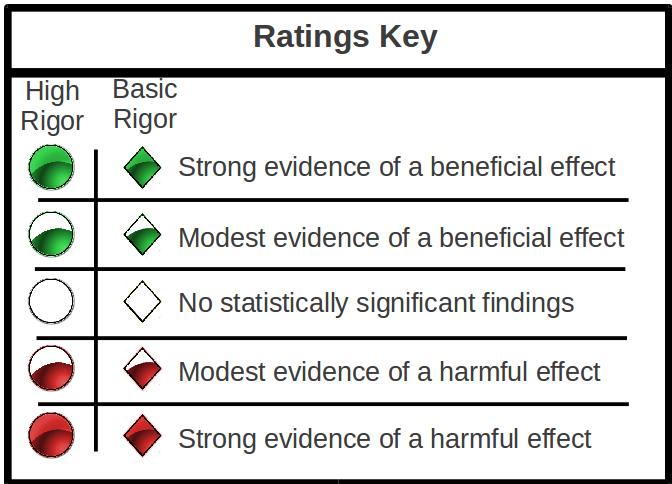Brand Name Programs
At times, particularly innovative or successful reentry programs gain national attention based on their design features and their potential impact on reducing recidivism. These programs are typically well funded and provide multiple services to address the variety of challenges people face when exiting correctional facilities. Given the high-profile nature of these programs, other jurisdictions tend to consider them models for replication, and as such, they are often the subject of rigorous, highly publicized evaluation. These types of well-known programs often cultivate a brand name in the field of reentry.
This page provides an overview and examination of key evaluative research investigating the relationship between brand name reentry programs and recidivism reduction. Below, we highlight the results and conclusions of research on these programs that met our criteria for methodological rigor, and provide a basis for comparing and discussing these programs.
… (more)
-
Auglaize County Transition (ACT) ProgramEvaluations:1 Basic RigorThe Auglaize County Transition (ACT) Program is a multi-faceted jail reentry program that was implemented in 2004 by the Auglaize County, Ohio, Sheriff’s Office; the program was designed to improve the recidivism, substance abuse, and employment outcomes of inmates returning from the Auglaize County Correctional Center by connecting them to community-based services.
-
Boston Reentry Initiative (BRI)Evaluations:1 High Rigor
The Boston Reentry Initiative (BRI) is a multiagency initiative implemented in 2001 that was designed to ease the transition process for especially high-risk and violent male inmates released to Boston neighborhoods from the Suffolk County House of Correction.
-
Center for Employment Opportunities (CEO)Evaluations:1 High Rigor
The Center for Employment Opportunities (CEO) opened in New York City in the 1970s, became an independent nonprofit corporation in 1996, and has since expanded to several locations around the country.
-
ComALERTEvaluations:1 High Rigor
ComALERT is designed to reduce recidivism among parolees returning to Brooklyn by providing a variety of services intended to ease the transition process; a central goal of the program is the reduction of substance abuse through weekly one-on-one meetings with a counselor and group treatment sessions.
-
Modified Therapeutic Community for Mentally Ill Chemical Abusers (MICAs)Evaluations:2 Basic Rigor
Typically, modified TC programs for MICA clients maintain the core elements common in traditional TC programs (eg, community meetings, progression through program phases, and group-level social activities), while also adopting various methods of mental health treatment (Van Stelle & Moberg 2004).
-
New Jersey State Parole Board Day Reporting CenterEvaluations:1 High Rigor
The New Jersey State Parole Board Day Reporting Center (DRC) began operations in 2006, when the New Jersey State Parole Board moved to adopt an evidence-based approach to parole supervision; DRCs were created as nonresidential, multiservice centers to serve those with technical violations of parole conditions or as a condition of parole upon release.
-
New Jersey State Parole Board Halfway Back Program (HWB)Evaluations:1 High RigorThe New Jersey State Parole Board Halfway Back Program (HWB) began in 2006, when the New Jersey State Parole Board moved to adopt an evidence-based approach to parole supervision;HWB was created as a structured approach to increasing returning prisoners’ success while on parole – the program offers residential facilities that serve either as an alternative sanction to parole revocation or as a condition of parole upon release.
-
Preventing Parolee Crime ProgramEvaluations:1 High RigorThe Preventing Parolee Crime Program (PPCP), originally funded in 1998 by the California State Legislature and overseen by the California Department of Corrections, was developed to offer a wide array of reentry services to parolees, including employment assistance, substance abuse treatment, drug education, computer-assisted math and literacy training, and a residential multiservice program.
-
Project GreenlightEvaluations:1 High RigorProject Greenlight was an intensive, 8-week program was delivered in the Queensboro prison facility to male inmates nearing release and planning to return to New York City, its ultimate goal was to smooth the transition to the community and thereby reduce recidivism.
-
Psychoeducational Component of the EQUIP ProgramEvaluations:1 Basic Rigor
The EQUIP program is a multicomponent cognitive-behavioral program, and the study reviewed here investigates the psychoeducational component of the program, the goal of which is to foster strong interpersonal skills between inmates and within inmate group classes in order to reduce within-facility infractions as well as recidivism upon release to the community.
-
San Juan County DWI ProgramEvaluations:2 Basic Rigor
Modeled after a similar intervention developed in Prince George’s County, Maryland, the San Juan County DWI Program was designed to address alcohol-related motor vehicle crashes by targeting 1st-time DWI offenders.
-
San Juan County DWI program with Victim Impact PanelsEvaluations:1 Basic RigorThis study evaluated Victim Impact Panels (VIP), which were implemented in June 1996 as a component of the San Juan County Detention/Treatment program for court-defined first-time DWI offenders – the panels are designed to underscore for participants the dangers of drinking and driving, emphasizing for participants that they could have been responsible for the injury or death of another individual.
-
Therapeutic Community: Amity In-Prison Therapeutic CommunityEvaluations:1 High Rigor1 Basic Rigor
The Amity In-Prison Therapeutic Community (TC) program was first implemented in 1989 at the medium-security RJ Donovan Correctional Facility in San Diego, California and occupied a 200-person housing unit within the prison.
-
Therapeutic Community: CREST Therapeutic Community ProgramEvaluations:1 High Rigor1 Basic Rigor
To address the needs of incarcerated individuals diagnosed with substance abuse problems, the Delaware Correctional System implemented a multistage therapeutic community (TC) that was designed to offer a continuum of treatment.
